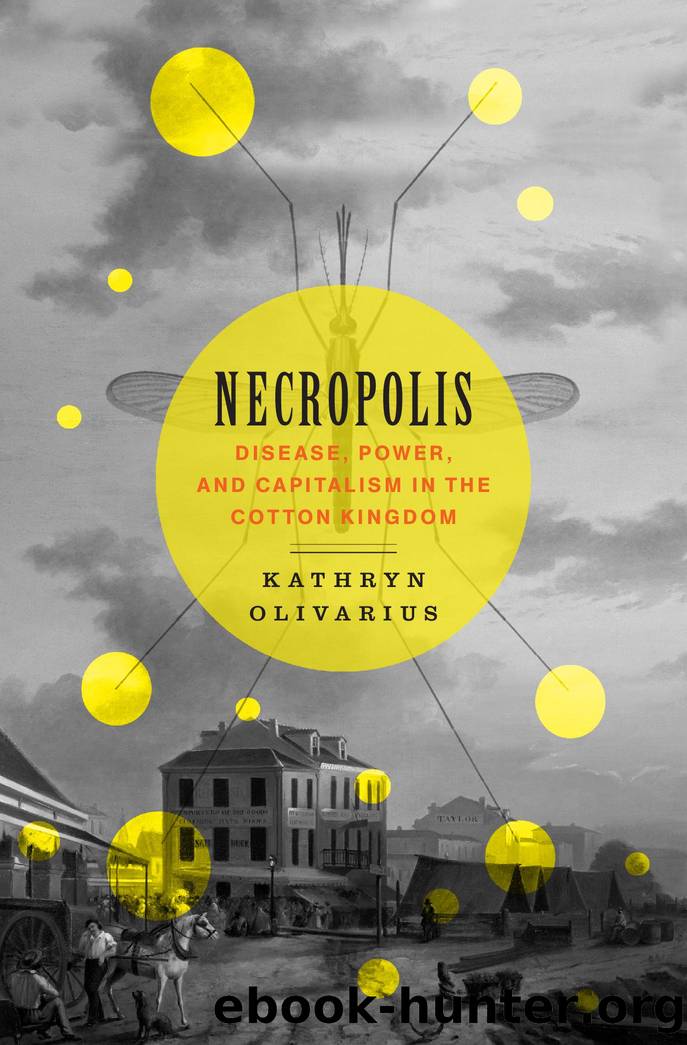Necropolis by Kathryn Olivarius

Author:Kathryn Olivarius
Language: eng
Format: epub
Publisher: Harvard University Press
Sanitation
Even though quarantines were too controversial to seriously consider, sanitation schemes like swamp drainage, street cleaning, and garbage removal could find bipartisan support. Such programs were cheaper than quarantine, and sanitarians also genuinely believed that suppressing miasmas and sweetening âfoul airsâ were crucial to disease prevention. Historian Melanie Kiechle has noted that according to nineteenth-century science, miasmas were the literal cause of illness. If a woman covered her nose while walking past a reeking abattoir or while descending into a dank cellar, this was not just a reflexâit was prophylactic. Visitors to New Orleans made a point of commenting on the cityâs uncommon filthiness and smelliness, noting that the swamps behind town emitted foul vapors; that the levee was trash-strewn; and that streets were indistinguishable from latrines after a light rainfall. The cityâs natural low-lying conditionâcombined with its heat and filthâcreated dangerous conditions.64
Early in the American Period, New Orleansâs residents complained that the stench was unbearableâand the city council took steps, albeit small ones, to improve conditions. After several citizens protested in June 1804, for example, that the barges waiting in port were âinjuriousâ to health because of âthe putrid miasmes emanatingâ from âdecomposing foodstuffs or ⦠the filth of animals on board,â the city council resolved that all barges carrying food and animals must unload above Poydras Street (uptown) or below the cityâs shipyard fronting the French Quarter. Violations would merit a $10 fine. The council also mandated that butchers remove all accumulated âblood, excrements, horns with bits of flesh, in fact all filthâ from their shops and throw it into the Mississippi to prevent âvery contagious diseases.â Officials laced sausage with poison to kill rabid dogs and paid enslaved workmen to remove the caninesâ carcasses. It also barred soldiers from defecating on the river bank, which had offered âat once a spectacle of the most revolting indecency and nastinessâ and also worsened âpublic health.â65
But as the cityâs population swelled, so did the cityâs abounding filth. This became increasingly hard to ignore, even for those with the most ironclad stomachs.66 Garbage and sewage were produced much faster than they could be removed. By 1851, Dr. E. H. Barton had estimated that New Orleansâs 130,000 residents produced 5,633 tons of sewage and 43,000 tons of urine each year. Animals produced a further 50,000 tons of waste. And if the 3,000 dead bodies interred each year were added to the weight of âorganic matter submitted to the putrefactive fermentation,â this made for a whopping 150,000 tons of organic waste, within an area of 7.25 square miles. All this organic waste contaminated the purity of the air New Orleanians breathed, poisoned the water they drank, and caused epidemics. British sociologist Harriet Martineau described New Orleans as âpeculiarly unhealthyâ compared to all the other cities she had visited on her American tour in the 1830s. She was distressed to hear that parents would only let their children play outdoors if the wind was blowing in from Lake Pontchartrain. Otherwise, the air was too dangerous to breathe.
Download
This site does not store any files on its server. We only index and link to content provided by other sites. Please contact the content providers to delete copyright contents if any and email us, we'll remove relevant links or contents immediately.
Harry Potter and the Goblet Of Fire by J.K. Rowling(3046)
Never by Ken Follett(2884)
Shadow of Night by Deborah Harkness(2719)
Ogilvy on Advertising by David Ogilvy(2682)
Zero to IPO: Over $1 Trillion of Actionable Advice from the World's Most Successful Entrepreneurs by Frederic Kerrest(2398)
The Man Who Died Twice by Richard Osman(2300)
Machine Learning at Scale with H2O by Gregory Keys | David Whiting(2293)
Book of Life by Deborah Harkness(2263)
How Proust Can Change Your Life by Alain De Botton(2261)
My Brilliant Friend by Elena Ferrante(2224)
0041152001443424520 .pdf by Unknown(2220)
The Tipping Point by Malcolm Gladwell(2205)
How to Pay Zero Taxes, 2018 by Jeff A. Schnepper(2100)
Will by Will Smith(2043)
Purple Hibiscus by Chimamanda Ngozi Adichie(1982)
Hooked: A Dark, Contemporary Romance (Never After Series) by Emily McIntire(1965)
Borders by unknow(1786)
Rationality by Steven Pinker(1765)
Daughter of Smoke and Bone by Laini Taylor(1744)
